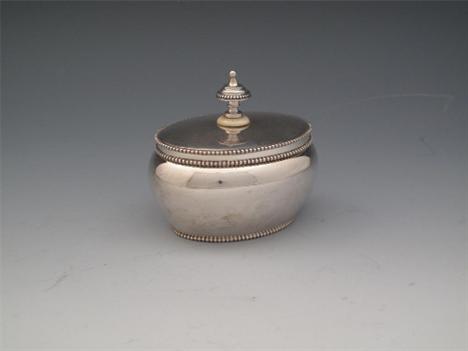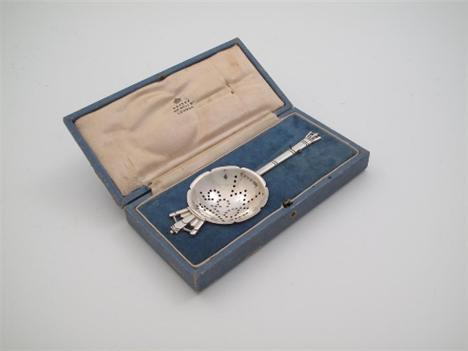A modern three-piece novelty silver owl condiment set, by R. Comyns, London 1967, comprising a mustard pot, and a salt and pepper pot, modelled as standing owls with glass eyes, the mustard pot with a hinged cover and with a mustard spoon with a mouse finial, height of mustard pot 7.8cm, approx. weight 9oz. (3)
We found 116061 price guide item(s) matching your search
There are 116061 lots that match your search criteria. Subscribe now to get instant access to the full price guide service.
Click here to subscribe- List
- Grid
-
116061 item(s)/page
A Britannia standard silver tea pot on stand, by Lionel Alfred Critchon, London 1910, in the Queen Anne manner, pear form, domed hinged cover with a knop finial, scroll handle, the stand of circular form, on the scroll legs on bun feet, with a burner and wooden baluster handle, height 24.5cm, approx. weight 35oz. (2)
A George III silver-gilt teapot, by Daniel Pontifex, London 1796, panelled oval form, engraved with bright-cut borders and cartouches, scroll handle, raised hinged cover with a crown finial, the body engraved with a coat of arms, length 28cm, approx. weight 19oz. ** The arms are those of Smith quartering Curtis, impaling Marriott quartering Pearson for the marriage on the 13th May 1797 of Sir John Wildbore Smith, 2nd Bt. of Sydling St. Nicholas, Dorset to Elizabeth Anne, daughter of the Reverend James Mariott.
A Victorian silver tea pot, by Walter Morrisse, London 1850, of bellied form, with embossed foliate, scrolling decoration, vacant cartouch, raised cover with flower finial, plus a Victorian silver sugar basin, by Daniel and Charles Houle, London 1850, of similar design, on four scroll feet, gilt interior, approx. weight 27oz. (2).
A George III silver cup and cover, by Rebecca Emes and Edward Barnard, London 1813, campana form, reeded side handles with foliate mounts, engraved foliate decoration, the pull off cover with a cauliflower finial, on a raised circular foot, engraved with an armorial, and inscribed, ` Presented by a friend, John Lloyd Esq. as a small memorial of the indefatigable zeal, distinguished ability and undaunted firmness by which he contributed in so essential a manner to rush the alarming disturbances of the country in the year 1812,` height 26cm, approx. weight 36oz. ** The arms are those of Lloyd of Hertfordshire and of Pembrokeshire.
A fine set of four George III silver two-handled sauce tureens and covers, by Paul Storr, London 1816, panelled oval form, applied with trailing oak leaves and acorns, the handles modelled as branches, the pull off cover with fluted decoration and a finial modelled as a rampant lion holding a cross, on four acanthus leaf mounted shell scroll bracket feet, engraved with two armorials, the interiors with silver liners, numbered 5, 6,7,and 8, length handle to handle 26cm, height 16.5cm, approx. weight 256oz. (4) Provenance: Sir Henry Russell, (1751-1836) 1st Baronet, and thence by descent to the current owner. Sir Henry Russell was born in Dover, third son of Michael Russell (1711-1793, controller of the Naval Victualling Yard there. He was educated at Charterhouse and Queen`s College Cambridge and then was appointed a Commissioner of Bankruptcy in 1775. In 1782, two years after his first wife died in child labour, he married Anne Whitworth with whom he went on to have five sons and four daughters. He was appointed a Judge in the Indian Courts in 1797 and Chief Justice of Bengal in 1806. He was created a Baronet in 1812 and retired from the Indian service in 1813. He died at 62 Wimpole Street, London in 1836. These four tureens were originally part of a set of eight, which are mentioned an accompanying `Estimate of plate on approbation for Sir Henry Russell Bart. P. Rundell Bridge and Rundell, December 20th 1815.` They cost £415 and 10s. The other four tureens from this set appear in the Christie`s Bi- Centinery Review of the year October 1965 - July 1966, page 125. They were from the collection of Neville Hamwee and fetched £3,300.
A mixed lot of silver flatware, various dates and makers, comprising: A Dutch spoon with a windmill finial, a set of four tablespoons, a pair of tablespoons, two caddy spoons, a pair of sugar tongs, a condiment ladle, seventeen golf spoons, a baby pusher and three teaspoons, approx. weight 27oz. (qty)
19th century French gilt-metal and porcelain clock garniture, the clock with bird finial above broken arch pediment, the porcelain dial depicting blue-tit and nest to centre, surrounded by gilt metal egg and dart decoration over similar hand-painted panel flanked by cherubs and courting doves below, the garniture urn-shaped vases with gilt-metal ram`s head handles, the porcelain body in the vase hand-painted with birds, the gilt metal base with similar painted porcelain panel, the clock having 8-day bell striking movement, clock 34cm high
A large scratch built model of a live steam horizontal mill engine, the single cylinder with mahogany plank cladding, brass drain cock and oiler cups, fish belly connecting rod, crosshead guides, open crank with spoked flywheel, eccentric drive to side steam valve, eccentric driven vertical water pump having decorative side supports, bevel gear linkage to brass ball speed governor terminating with acorn finial. The engine is partly surrounded with polished steel posts and handrails. On plinth 50cm x 26cm.
A George III small silver two handled cup and cover, by John Wakelin and William Taylor, London 1790, of vase shape on a pedestal circular foot, the lower half of the body chased with acanthus leaves, the domed cover with an acorn finial, with reeded scroll handles and borders, engraved with a coat of arms and crest, 21cm high, 15oz (2). The arms are those of Philip Stanhope, 5th Earl of Chesterfield, and his wife, Anne, daughter of Rev. Robert Thistlehawyte, whom he married in March 1773. She died 20 Oct 1798 leaving a daughter, Harriett, who never married and died in 1803. In 1799, the Earl married secondly Henrietta Thynne, daughter of 1st Marquess of Bath. She who bore one son (George, 6th Earl) and two daughters. He held the appointment of Master of the Horse. He was installed as a Knight of the Garter on St George`s Day 1805 and died 29 Aug 1815.
A continental silver spoon in the 17th century manner, the finial modelled as a man holding his rifle with his hound jumping up in excitement, 18.25cm long, and a small collection of late 19th/early 20th century continental silver comprising: a Russian vodka beaker, 5cm high, a Russian salt of compressed circular form, 3.5cm high, another beaker embossed with foliage, 9.5cm high, and a cream jug, import hallmarked London 1886, foliate embossed baluster form on hoof feet, 10cm high (5)
A George III silver tea urn and cover, by Daniel Smith and Robert Sharp, London 1765, the ovoid shaped body with gadroon borders and shell and gadroon loop handles, the detachable pedestal square stand with a waisted section, pierced with geometric motifs, resting on claw and ball feet, the detachable high domed cover with a pierced flame finial, the spigot with a turned ebony handle, engraved with coat of arms and crest, 48.5cm high, 92oz. The arms are those of Taylor, these arms are based on those granted to Taylor of Eaton, Bedfordshire.
A 17th century Norwegian parcel gilt spoon, maker`s mark unknown, Bergen, with ball finial and spiral twisted stem with an engraved lower section, the top of the bowl engraved with `IHS` within circular cartouche, the scrollwork below, 13.5cm long, and an unmarked silver spoon, with ball finial and spiral twisted stem, 13.5cm long (2)
A Russian Silver Judaica Inkwell. The drum shaped vessel having a crest to the front and St George & the Dragon to the back, a hinged lid with finial knop to the top and two dressed rats mounted either side: one with a dagger, the other with an axe. Standing on small ball feet 3¼ ins (8 cms) in height.
A Small & Decorative Flemish Glass Beaded Wirework Chandelier of basket form. The crowning top section hung with six long beaded strands. The sides composed of flower-head rosettes forming panels and draped with bow topped beaded swags & tear drops. Terminating with a faceted pendant ball finial. 29 ins (74 cms) drop, 13 ins (33 cms) in width.
A Pair of Decorative 19th Century Serving Plates and a Biscuit Barrel with wicker handle. The biscuit barrel of cylindrical form having a flat lid with finial knop and decorated in flow blue & sanguine printed urns of flowers clobbered in rust orange and green overglaze with gilt details. The plates decorated with blue, pink, orange & green flowers and having serpentine borders with moulded rope-twist edging and scroll handles, 9 ins (23 cms) in diameter.
-
116061 item(s)/page
























































